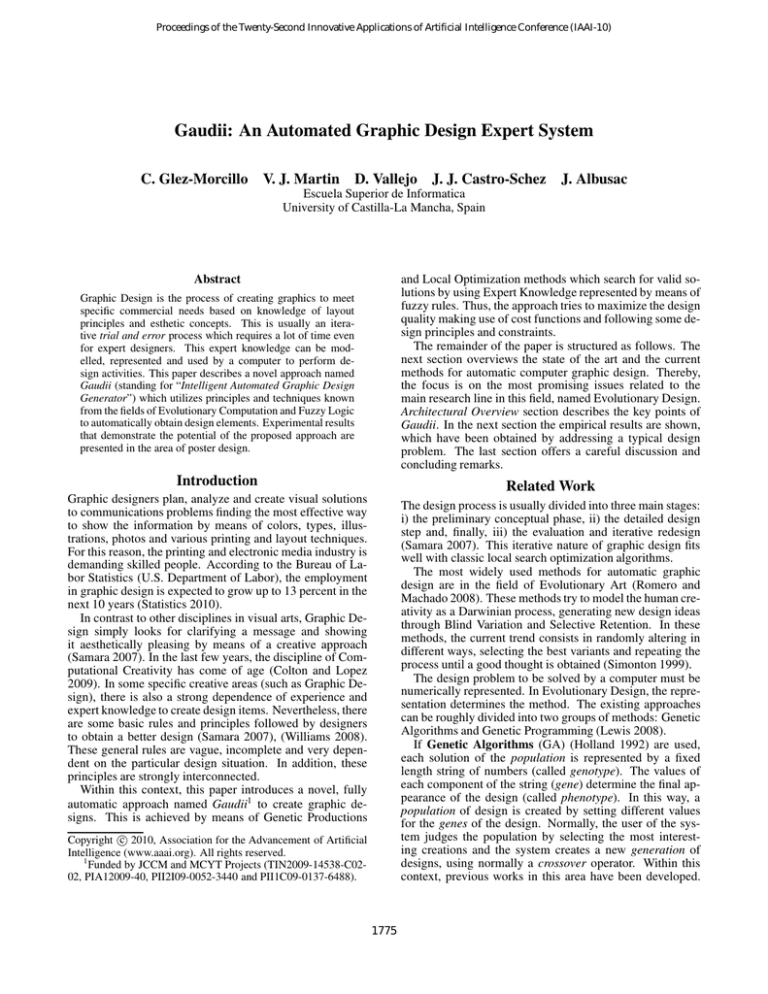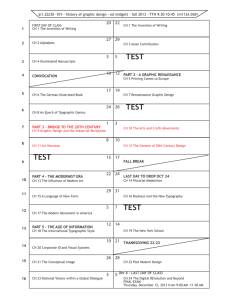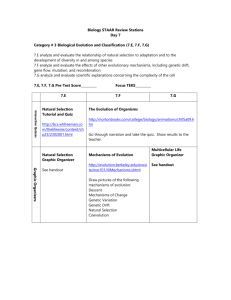
Proceedings of the Twenty-Second Innovative Applications of Artificial Intelligence Conference (IAAI-10)
Gaudii: An Automated Graphic Design Expert System
C. Glez-Morcillo V. J. Martin
D. Vallejo J. J. Castro-Schez
J. Albusac
Escuela Superior de Informatica
University of Castilla-La Mancha, Spain
Abstract
Graphic Design is the process of creating graphics to meet
specific commercial needs based on knowledge of layout
principles and esthetic concepts. This is usually an iterative trial and error process which requires a lot of time even
for expert designers. This expert knowledge can be modelled, represented and used by a computer to perform design activities. This paper describes a novel approach named
Gaudii (standing for “Intelligent Automated Graphic Design
Generator”) which utilizes principles and techniques known
from the fields of Evolutionary Computation and Fuzzy Logic
to automatically obtain design elements. Experimental results
that demonstrate the potential of the proposed approach are
presented in the area of poster design.
and Local Optimization methods which search for valid solutions by using Expert Knowledge represented by means of
fuzzy rules. Thus, the approach tries to maximize the design
quality making use of cost functions and following some design principles and constraints.
The remainder of the paper is structured as follows. The
next section overviews the state of the art and the current
methods for automatic computer graphic design. Thereby,
the focus is on the most promising issues related to the
main research line in this field, named Evolutionary Design.
Architectural Overview section describes the key points of
Gaudii. In the next section the empirical results are shown,
which have been obtained by addressing a typical design
problem. The last section offers a careful discussion and
concluding remarks.
Introduction
Related Work
Graphic designers plan, analyze and create visual solutions
to communications problems finding the most effective way
to show the information by means of colors, types, illustrations, photos and various printing and layout techniques.
For this reason, the printing and electronic media industry is
demanding skilled people. According to the Bureau of Labor Statistics (U.S. Department of Labor), the employment
in graphic design is expected to grow up to 13 percent in the
next 10 years (Statistics 2010).
In contrast to other disciplines in visual arts, Graphic Design simply looks for clarifying a message and showing
it aesthetically pleasing by means of a creative approach
(Samara 2007). In the last few years, the discipline of Computational Creativity has come of age (Colton and Lopez
2009). In some specific creative areas (such as Graphic Design), there is also a strong dependence of experience and
expert knowledge to create design items. Nevertheless, there
are some basic rules and principles followed by designers
to obtain a better design (Samara 2007), (Williams 2008).
These general rules are vague, incomplete and very dependent on the particular design situation. In addition, these
principles are strongly interconnected.
Within this context, this paper introduces a novel, fully
automatic approach named Gaudii1 to create graphic designs. This is achieved by means of Genetic Productions
The design process is usually divided into three main stages:
i) the preliminary conceptual phase, ii) the detailed design
step and, finally, iii) the evaluation and iterative redesign
(Samara 2007). This iterative nature of graphic design fits
well with classic local search optimization algorithms.
The most widely used methods for automatic graphic
design are in the field of Evolutionary Art (Romero and
Machado 2008). These methods try to model the human creativity as a Darwinian process, generating new design ideas
through Blind Variation and Selective Retention. In these
methods, the current trend consists in randomly altering in
different ways, selecting the best variants and repeating the
process until a good thought is obtained (Simonton 1999).
The design problem to be solved by a computer must be
numerically represented. In Evolutionary Design, the representation determines the method. The existing approaches
can be roughly divided into two groups of methods: Genetic
Algorithms and Genetic Programming (Lewis 2008).
If Genetic Algorithms (GA) (Holland 1992) are used,
each solution of the population is represented by a fixed
length string of numbers (called genotype). The values of
each component of the string (gene) determine the final appearance of the design (called phenotype). In this way, a
population of design is created by setting different values
for the genes of the design. Normally, the user of the system judges the population by selecting the most interesting creations and the system creates a new generation of
designs, using normally a crossover operator. Within this
context, previous works in this area have been developed.
c 2010, Association for the Advancement of Artificial
Copyright Intelligence (www.aaai.org). All rights reserved.
1
Funded by JCCM and MCYT Projects (TIN2009-14538-C0202, PIA12009-40, PII2I09-0052-3440 and PII1C09-0137-6488).
1775
each developed module. Next, the functionality of the devised stages, including the related modules that form them,
will be described.
The system conceived by (Geigel and Loui 2003) uses a
GA to evolve album page layouts by using a 4-tuple for the
genotype (coordinates, scale and rotation). The design tool
“evoDesign”, developed by (Anderson et al. 2008), employs
GA to evolve the tiles used for fabrics and wallpapers. In this
work, the authors focused on creating intuitive genotypephenotype mappings, allowing the user to lock good elements on the design. In (Quiroz et al. 2009), the individuals
of the population are evaluated on a set of objective heuristics for document design (page layout) and subjectively by
the user of the system.
The other family of methods belongs to the Genetic Programming (GP) (Koza 1992) field. Unlike the previous
methods, the representation is based on a hierarchical graph,
usually representing a mathematical expression. In this expression, the operators are located on internal nodes and
constants and variables at leaves. The phenotype is obtained
applying the function of the graph to every pixel in the image. The results obtained from GP methods are usually organic (see (Romero and Machado 2008)) and fractal-landed
and inappropriate for many graphic design applications.
(Bentley and Corne 2002) and (Romero and Machado
2008) have excellent surveys on Creative Evolutionary Systems, including expression-based imaginary, fractals, image
processing and other related techniques.
Gaudii significantly differs from the aforementioned
works in its general and extensible approach, and the blackbox approach from the point of view of the final user. No
previous knowledge of design or evolutionary computing is
needed. Most of the evolutionary design systems require a
qualitative background of knowledge of these techniques to
be used. There are some hard concepts for inexpert users,
such as the set up of related probabilities (crossover, mutation, etc). Also the existing solutions tend to be very specific for the design problem. Gaudii identifies multiple independent modules which can be suitable for a wide range of
graphic design scenarios. Combining key features of Evolutionary Computation and integrating an Expert System with
Local Optimization methods configure Gaudii as a novel approach to generate Graphical Design elements.
Analysis and Preprocessing
This stage takes the data provided by the user as input; texts
and images which can be semantically grouped, as well as
keywords (optional for the automatic search of related images on the Internet) and preferences. The definition of semantic groups allows to arrange the related items and give
a considerable importance to each item of the group. Each
group is formed by one or more elements of text or images
within five categories: title, subtitle, important, regular, and
notes (see the example in the Experimental Results section).
The Knowledge Acquisition Module (KAM) supports the
acquisition of preferences by means of five initial questions:
1. (Q1) Do you prefer portrait or landscape designs?
(Portrait / Landscape / I don’t mind)
2. (Q2) What kind of typography do you like?
(Formal fonts / Fancy fonts / I don’t mind)
3. (Q3) Do you prefer dark or light designs?
(Dark / Light / I don’t mind)
4. (Q4) Do you want a grayscale or color design?
(Grayscale / Color / I don’t mind)
5. (Q5) Where does Gaudii get the key tones?
(From the image / I want to force a schema / I don’t mind)
The output of this stage consists of a set of Raw Design
Elements and the user’s preferences (obtained by the KAM).
These Raw Design Elements are the set of images chosen
for the design with their definition of the Area of Interest
(explained later) and the semantic groups (text and related
images), and the user’s preferences.
Obtaining Visual Elements. This module is responsible
for obtaining the images of the design. These design items
can be directly provided by the user or can be obtained from
the list of keywords supplied by the user. The KAM is used
to ask the user for selecting the key image of the design.
This image is sent to the next module.
Gaudii Architectural Overview
Visual Interest Analysis. This module defines the most
interesting visual area of the key image of the design. This
module uses a set of submodules specialized in the image
analysis and an Interest Composition Function (ICF) that
combines the output of such submodules, obtaining the final
Area of Interest. The current version of Gaudii implements
three analysis submodules:
The most widely used approach in the automatic generation
of designs is based on evolutionary techniques. As previously discussed, this kind of method shows some disadvantages that can be overcome thanks to a hybrid approach. In
this way, Gaudii can be understood as a hybrid system composed of four key stages: Analysis and Preprocessing, Genetic Production, Expert Knowledge Kernel, Composition
and a general Knowledge Acquisition Module (see Figure
1). This module is used to acquire knowledge from users
when needed. This module requires the interaction with
the user in few stages because of the autonomous nature of
the Gaudii approach. Some of this functionality will be explained in the context of the related stages.
The key stages are designed taking into account future
extensions and provide loose coupling by means of the definition of intermediate data that allows to make changes and
integrate new functionality in each module without affecting
the rest. Thus, it is possible to independently run and debug
• Face Detection, which detects human faces using a Haar
Classifier. In the case of multiple detection, the submodule returns the best one (defined as the bigger and
well-located, following the compositional rule of thirds
(Samara 2007) used in photography).
• Object Detection: which searches for isolated objects in
the image, using the previous explained criteria in the case
of multiple detection.
• Manual: the KAM module provides an Ajax web interface for the user to manually obtain the area.
1776
Figure 1: Representation of the main modules of the Gaudii architecture.
Genetic Production
The Genetic Production stage is a controlled Genetic Algorithm. Some chromosomes are not allowed because of the
inter-dependencies of some genes. These dependencies are
checked in the Consistency Test module. This stage takes
as inputs the outputs of the previous stage (Raw Design Elements and the User’s Preferences) and produces as output a
Genetic Population (set of chromosomes) that will be used
in the next stage.
In this stage, a population of genotypes (denoted from now
as chromosomes) is created. Each member of the population
defines the general attributes of a graphic design that will
be concreted in the next stage. The specific attributes of
each Design Element (such as size, color or position) will
be decided in the next stage.
Each gene of the chromosome defines a general characteristic of the design, taking integer values that range from
0 and 9. In Gaudii , the chromosome has a fixed size of 24
genes grouped by purpose in 4 categories: Document, Contrast, Repetition and Composition (Table 1 shows some of
them). These genes have a correspondence with some of the
input variables used in the Knowledge Base of the next stage
(Expert Knowledge Kernel).
G
Group
1
2
3
6
7
8
10
13
14
15
16
18
23
24
Document
Document
Document
Document
Contrast
Contrast
Contrast
Contrast
Repetition
Repetition
Repetition
Repetition
Composit.
Composit.
Initial Generation. This module, as in most evolutionary
design-based applications, randomly generates the population by assigning values to the free genes of the chromosome
(between 0 and 9 in Gaudii ). Some of the genes can be fixed
by the KAM (because of the User’s Preferences or during the
generation) and cannot be changed in the whole generation
process. This random initialization guarantees the diversity
of the initial population and the phenotypes (final designs).
Description
Consistency Tests. This module makes use of a base of
consistency rules to detect and resolve inconsistencies between genes that deal with a common aspect. For instance,
Table 1 shows that the genes 8 and 15 can be contradictory
if they take opposed values (e.g. a high contrast level between font colors and a high repetition level of such colors).
These tests are used when a chromosome changes (in the
initialization process or crossover and mutation).
Aspect Ratio (0 = Square, 9 = Panoramic)
Portrait or Landscape
Main Font Style (Graphic, Sheriff...)
Use main image as background of design
Contrast level between size of fonts
Contrast level between colors of fonts
Use fancy text decoration for contrast
Use Capitals in text
Use similar size of fonts
Use similar colors in fonts
Use same shape in fonts (as Main image)
Repeat the main font as secondary
Crop key image around the Area of Interest
Use text or image borders
Crossover and Mutation. By means of the KAM, the system allows the user to choose a set of interesting final design
items and combine them to create a new generation of individuals. This can be done only after the four stages have
finished (and a set of final designs are shown to the user)2 .
2
In the current implementation of Gaudii , the crossover is done
with two or more parents using a drag&drop Ajax web interface.
Table 1: Short description of some genes.
1777
The size of the population is small to avoid the user’s fatigue (Takagi 2001) (in Gaudii is fixed to 12). The probabilities of crossover and mutation are dynamically adjusted
by the KAM module with no user’s interaction. There is
no fitness function; the chromosomes only represent general attributes. The quality of each solution depends on the
concrete properties (position, size, color...) of each element,
which will be optimized in the next stage.
Expert Knowledge Kernel
In this stage, the Raw Design Elements and the chromosomes of the population of the previous stage are processed
in order to get the Final Design Data (items formatted according to concrete attributes). The chromosome associated to each design is evaluated by making use of the expert knowledge existing in the Knowledge Base (KB). This
KB is formed by a set of fuzzy rules that models general
graphic design principles. Each potential design solution is
optimized using a Local Optimization module that decides
the final Physical distribution of the design elements.
The output of this stage is the specific information for
each design element. In other words, the Raw Design Elements are converted into Final Design Data that contains
the information needed by the Composition stage to produce
the final image. The concrete individual properties of each
element are obtained in the Generation of Processed Design
Elements Module and the physical distribution of each element in the document is obtained in the Local Optimization
Module.
Figure 2: Definition of the fuzzy sets in a rule.
Each variable has its own fuzzy sets. Triangular and trapezoidal functions were used for each linguistic label associated to the linguistic values, as shown in Figure 2. To obtain
the output of each rule, Mamdani’s Inference System with
minimum T-norm and maximum T-conorm is used.
Generation of Processed Elements. This module uses the
output (consequents) of the fuzzy rules and obtains concrete
attributes for the Raw Design Elements. This information
will be sent to the Local Optimization module to obtain the
final physical distribution.
These concrete attributes for the design elements are obtained using four submodules of functions:
• Document: These functions generate the final size of the
document (using the document ratio), the size of margins
and the final size (in mm) of design elements.
Fuzzy Knowledge Base. A set of fuzzy rules (Zadeh
1975) is used to model the expert knowledge and obtain particular values of some of the properties of the design items
that correctly behave according to basic design principles.
The sets of fuzzy rules are widely used due to the descriptive
power and extensibility when modelling expert knowledge.
The current version of Gaudii uses a set of 128 rules,
generated by a human expert, grouped into the categories
of Contrast, Repetition, Layout and Composition (Williams
2008). These rules are loaded into the system through and
XML file3 . Next, an example of two rules of contrast used
by the system is shown:
R18 : If CS is {S, M } ∧ RS is S → HO is B
R19 : If CS is B ∧ RS is {S, B} → HO is V B
The variables (antecedents and consequents) used in the
previous rule are as follows:
• Contrast of Size (Antecedent) [CS], defined over the set
of values {S, M, B}4 . This parameter corresponds to the
gene 7.
• Repetition of Size (Antecedent) [RS], defined over the
set of values {S, B}. This parameter corresponds to the
gene 14.
• Size of Title (Consequent) [H0], defined over {B, V B}.
It defines the size of the text of class “Title”.
• Color: The final color scheme is generated. These functions also check if the text is readable over the background.
• Typography: Using, at the most, two families of fonts
(Samara 2007) these functions select the text attributes.
• Pre-composition: These functions prepare the results
with some extra information required by the Local Optimization Module (such as free white space).
Local Optimization. This module obtains the final physical distribution of the design elements using a Simulated
Annealing algorithm. In local search methods, the definition of a cost evaluation function is needed. In Gaudii , this
evaluation is done by composing two cost functions:
• Balanced Cost: Each design element has a Visual Weight
determined by its type (title, subtitle, main image, etc).
The Balanced cost of the composition is obtained using
the mean point of each design element multiplied by its
Visual Weight. A polygon is constructed with a weighted
vertex (see Figure 3.h). Then, the centroid is calculated. If
the centroid is close to the geometric center of the composition (represented in Figure 3.h through a white circle),
the design is well-balanced.
3
The full list of rules and linguistic variables can be reached at
http://www.esi.uclm.es/www/cglez/gaudii/
4
The notation used for the linguistic variables is typical in some
works with Fuzzy Sets. This is the correspondence of the linguistic
variables: S is Small, M is Medium, B is Big and, finally, VB is
Very Big.
• Alignment Cost: This function forces to correctly align
the design elements to get a visual order (Samara 2007).
This cost is computed by means of the number of design
elements aligned to the alignment lines (see Figure 3.g).
1778
Figure 3: Case Study: (a-f) Selected examples obtained with the same input data. (g) Alignment lines for (f), defined automatically and used by the alignment cost function. (h) Visual balance by minimizing the value of the balanced cost function.
By default, the margins, the borders of the area of interest, are defined. Some specific aligned lines can be also
defined by this function, such as the eyes level in the case
of using a face as an area of interest.
• Keywords
Graphic Design, Paint, Atlanta, Artificial Intelligence
• User’s Preferences
Q1 (Portrait/Landscape): Don’t mind, Q2 (Formal/Fancy Fonts):
Formal, Q3 (Light/Dark Design): Light, Q4 (Grayscale/Color):
Grayscale, Q5 (Key tones?): From the image
• Group 1
Text - Title - Gaudii
Text - Subtitle - Automated Graphic Design Expert System
• Group 2
Image - IAAI Logo (.PNG Transparent)
Text - Emph - IAAI 2010
Text - Normal - 22nd IAAI Conference on AI
Text - Notes - Innovative Applications of Artificial Intelligence
/n Atlanta, Georgia, USA, July 1115, 2010
Since the implemented modules are independent each
other, it possible, for instance, to use Genetic Algorithms
to align the design elements. Within this context, the cost
evaluation function when using the Simulated Annealing algorithm can be easily replaced by a fitness function of GA.
The neighbor solutions are obtained by changing the position of the design elements. When the temperature of the
Simulated Annealing is high, large translations are allowed.
The more the temperature decreases, the smaller the modification of the position is.
• Group 3
Text - Emph - Paper Contents
Text - Normal - Introduction /n Related Work /n Architectural
Overview /n Experimental Results /n Discussion and Conclusion
Composition
In this last stage, the formatted design items are processed
to get the final image. This stage is independent of the previous stages of generation and allows for the integration of
multiple engines of image synthesis, raster or vectorial. The
KAM provides to the user the configuration of the chromosome (a XML file) in order to reuse it in future designs.
For users that are reluctant to blackbox approaches such as
Gaudii , the composition stage allows to easily include a
module to generate editable designs (e.g. by using as output
the ODG standard file format).
The user only entered the previous data in the system.
Some of the images provided by Flickr5 are shown to the
user to choose the main one. The Visual Interest Analysis
module, using an OpenCV Haar Classifier, detects a human
face and establishes the most interesting visual area.
Some selected examples obtained with this data are shown
in Figure 3 (a-f). The Genetic Production assures the variety
of the obtained elements, configuring some characteristics of
the final item which could be inherited by their offsprings.
For example, the chromosome (f) Cf is obtained as offspring
of the chromosomes of (c) Cc and (e) Ce of Figure 3:
Cc = {731919 : 785612 : 823516 : 570002}
Ce = {680913 : 584421 : 252606 : 672523}
Cf = {731919 : 785421 : 222609 : 672523}
Experimental Results
These results were obtained with the implementation
of Gaudii , which is available free for download at
http://code.google.com/p/gaudii/ under GPL3 Free Software
License, on a computer with the following specifications:
Intel Dualcore 2Ghz, 3GB RAM running Debian, Mongrel
Server 1.1, Ruby 1.9, Ruby on Rails 2.3 and OpenCV 2.0.
In the following example, three groups of design items
were defined:
5
Using the Ruby plugin flickr.rb, searching (using the keywords
provided by the user) the images with Creative Commons license,
ordered by Interestingness. Photo in Figure 3 by Carlo Nicora.
1779
• The proposed system combines good solutions and incorporates the subjective esthetic skills of the human as a
selective agent.
In this example, Cf inherits (random crossover) from Cc
the first 9 genes which determines for example the landscape
distribution of the creation (the value of the second gene is 3,
close to 0, which means a high probability of landscape distribution), and the high contrast level between size of fonts
(gene 7). The Consistency Test module corrects the value of
gene 14 of Cf because, as previously was explained, there is
a conflict with gene 7. There is also a mutation in the value
of gene 18 (value 9) which forces to use the same font in the
primary and secondary texts (using only one typography).
In Figure 3.g the align edges are shown. The elements
exactly situated in these edges obtained a better value in the
Alignment Cost function. Figure 3.h shows graphically the
computation of the balanced cost function. Each design element has its own visual importance (in the figure, the most
important, the darker) that is used to calculate the centroid
of the polygon. If the centroid is close to the center of the
design, the composition is well-balanced.
In the previously discussed example, the average time (in
seconds) for design item in each phase is: Genetic Production 0.003, Expert Knowledge Kernel 2.017 and Composition 0.901. The interactive time to search for the image in
Flickr and to specify the user’s preferences depends on the
user, but is usually shorter than 10 seconds for the full set of
design items (12 per iteration). Thus, the final time per design item is around 5 seconds, but it can be easily improved
by using distributed computing.
In order to get the final users’ feedback, a web system
(http://www.esi.uclm.es/www/cglez/gaudii/) for evaluating
Gaudii has been developed so that any user, distinguishing between the roles novice, amateur and professional, can
grade up to 6 designs randomly generated by Gaudii . The
statistics gathered by the web system shows that the generated designs are evaluated between good and excellent6 .
Extending Gaudii by means of some machine learning
technique opens a promising research line. For example, the
use of an inductive algorithm allow for the automatic learning of the dependency rules in mutations, and the dependencies of variables to obtain valid designs. The contents of
the knowledge base are critical for the performance of the
system and can be improved by learning from processed examples by expert designers. Future work also concentrates
on using more techniques from the Computer Vision field to
identify interesting areas in images, such as the use of visual
image descriptors, foreground/background isolation, etc.
References
Anderson, C.; Buchsbaum, D.; Potter, J.; and Bonabeau, E.
2008. Making interactive evolutionary graphic design practical. volume 88. Springer. 125–141.
Bentley, P., and Corne, D. 2002. Creative evolutionary systems. Morgan Kaufmann Pub. ISBN: 1-55860-673-4.
Colton, S., and Lopez, R. 2009. Computational creativity:
Coming of age. AI Magazine 30(3):11–14.
Geigel, J., and Loui, A. 2003. Using genetic algorithms for
album page layouts. IEEE multimedia 10(4):16–27.
Holland, J. H. 1992. Adaptation in Natural and Artificial
Systems: An Introductory Analysis with Applications to Biology, Control, and Artificial Intelligence. The MIT Press.
Koza, J. R. 1992. Genetic Programming: On the Programming of Computers by Means of Natural Selection (Complex
Adaptive Systems). MIT Press.
Lewis, M. 2008. Evolutionary Visual Art and Design (The
Art of artificial evolution), volume 226. Springer. 1–37.
Quiroz, J.; Banerjee, A.; Louis, S.; and Dascalu, S. 2009.
Document Design with Interactive Evolution. New Directions in Intelligent Interact. Multimedia Systems 309–319.
Romero, J., and Machado, P. 2008. The art of artificial evolution: A handbook on evolutionary art and music. SpringerVerlag. ISBN: 978-3-540-72876-4.
Samara, T. 2007. Design Elements: A Graphic Style Manual. Rockport Publishers. ISBN: 978-1-592-53261-2.
Simonton, D. 1999. Origins of genius: Darwinian perspectives on creativity. Oxford University Press, USA. ISBN:
978-0-195-12879-6.
Statistics, B. L. 2010. Occupational outlook handbook.
2010-2011 Edition (Updated December 2009). Available on
the Internet at http://www.bls.gov/oco/ocos090.htm.
Takagi, H. 2001. Interactive evolutionary computation: Fusion of the capabilities of EC optimization and human evaluation. Proceedings of the IEEE 89(9):1275–1296.
Williams, R. 2008. Non-Designer’s Design Book. Peachpit
Press. ISBN: 978-0-321-53404-0.
Zadeh, L. A. 1975. The concept of a linguistic variable
and its applications to approximate reasoning. part i, ii, iii.
Information Science 8(3):199–249.
Discussion and Conclusion
Due to its economic relevance, the Graphic Design occupation is predicted to have a long-term growth. In some cases,
the requirements of this in-demand occupation can be automatically achieved by computers (for example in the generation of posters to announce events). The expert knowledge
needed to perform these activities requires a new extensive
approach to model, represent and generate design solutions.
Gaudii has been developed in response to this challenge.
The hybrid model presented in this work, based on Evolutionary Computation principles, Fuzzy Rule-based Expert
Systems and Local Optimization offers several desirable features which together makes this approach unique and of
highest practical value:
• Gaudii is independent of the user knowledge and only
needs the input text to automatically provide some solutions for the design problem.
• Thanks to the independence of the implemented layers,
the system is intuitive (allowing several User Interfaces),
useful (in a wide range of application domains) and practical (solving real design problems).
• In contrast to Interactive Evolutionary Systems, Gaudii is
fast and does not need continuous human interaction.
6
http://www.esi.uclm.es/www/cglez/gaudii/results.php
1780




